Interview by Agata Kik
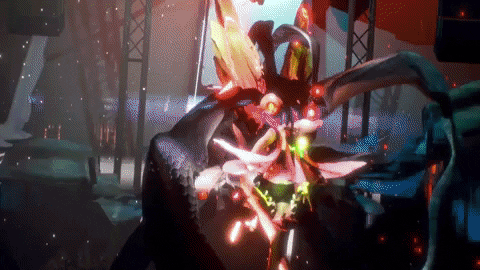
American artist Sam Rolfes plays musical chairs, switching between the roles of an experimental electronic musician, 3-D animator, VR performer, graphic designer, director and also a writer. His animations are improvised, his collaborations unconventional, while his performances are ever-more-complex thanks to his extra-experimental use of technology. He is also a co-founder of -the now-defunct- art and music collective Join The Studio and digital performance and image studio Team Rolfes; collaboratively with his brother Andy or his own, Rolfes works with VR, mixed reality, figurative animation and motion capture tools to create music videos, video games or live improvisational performances.
Rolfes’ surreal imagery, sometimes sublime and often psychosexual, explores human identity through contemporary computer-based image-making. Visceral, colour-saturated, full of moist flesh, taking place in wonderlands or in hell, his videos permeate the screen with juicy environments overflowing with thrilling microcosms of dreamy creatures. They feel uncanny, familiar and strange at the same time. They are like parallel universes that a computer click of magic lets us be transported into.
Resembling Candyland fairy tales from children’s nightmares, like in the music video Bunny’s Dream for Matthew Dear, or dystopian sci-fi scenario in the music video Ashes of Love for Danny L Harle and Caroline Polachek, all of the works by Rolfes are characterised by dizzying movement, tactile materiality and expansive 3-dimensionality looked at through the screen. They give a feeling of peeking through a swallowing wormhole. Their graphics are immersive, even though experienced as belonging to a flat surface. Carnal refers to corporeality, animalistic in nature, like video game graphics for Adult Swim, for example, which belong to the pink patterned world of beat-making meat.
It was his first music video for Amnesia Scanner when Sam initially experimented with VR live performance. The video for the track AS Chingy is based on a live recording of an Amnesia Scanner performance. The visual body horror goes hand in hand with the distorted electronic music. Even though alien-looking, the human body is in Sam’s works the main part of the graphics. It is this visceral connection to the human figure that gives rise to feelings of terror in the viewing subject. In Sam’s art practice, the body is treated as a mark-maker whose traces are scattered around through action with matter and simultaneously distributed digitally.
What is so particular about Sam’s use of technology is the fact that his live performances reveal the processes usually hidden from the eyes of the viewer. Motion caption tools are mostly intended for pre-recorded works, while in Sam’s practice, they pose the main part of live performances. While the performer’s dress is replaced by sensors and wires of mocap suits, their live presence is doubled by a digital puppet on a screen. Not only does the performer’s active avatar respond to the performer’s movements in real-time, but also the audience is encouraged to simultaneously interact and influence the show through their mobile phones, as experienced during the recent performance at MoMA in New York.
Such VR live performance is not about the representation of human movements but about the expansion of human physical presence into our real-time life in virtuality. Sam Rolfes has been tirelessly working on generating unexpected events through art and science crossovers, interdisciplinary partnerships and technology as an extension of his collaborators and his own bodies, such as the Shadow Motion mock-up suits system. Working with cutting-edge technology entails being related to the world’s biggest corporations, of whose hierarchical structures and profit-oriented strategies the artist is not uncritical, however as they claim, they do not pick these tools due to their fancy innovativeness, but rather because of their relation to the body and potential for expression.
With his energy entirely supplied by the feeling of urgency to create, comfortable with no bed, exchanging sleep for even more work, the performative presence of Sam Rolfes is like a blink of light on the speculative grounds of the future of technology, art and the human being. His ideas are stunning, and so his eyes never stop blinking.
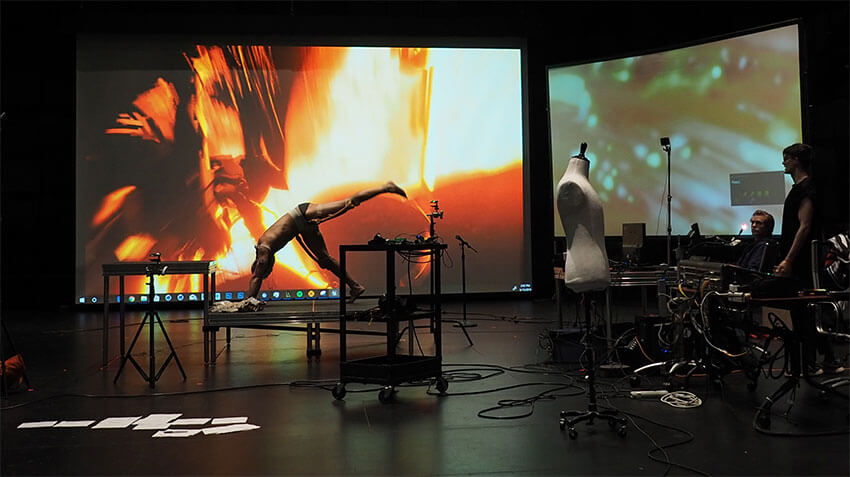
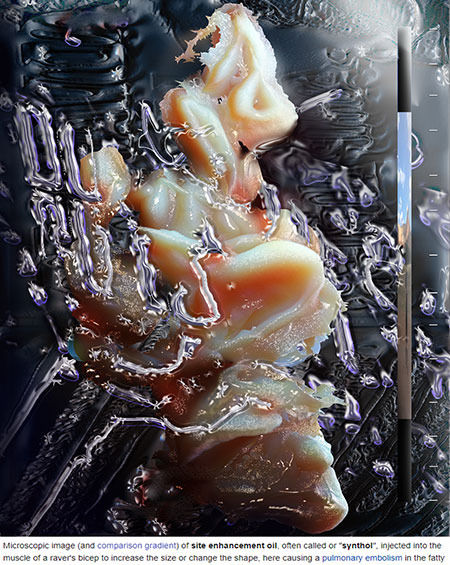
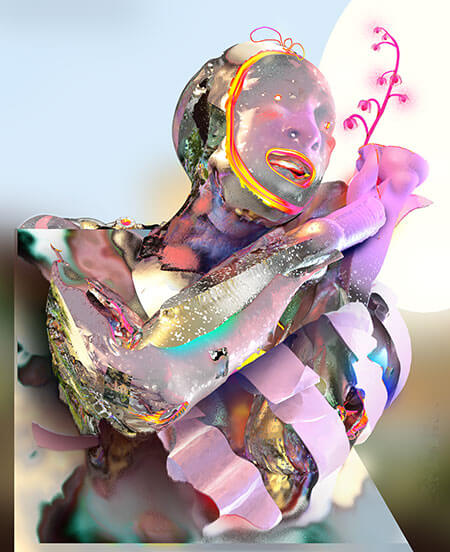
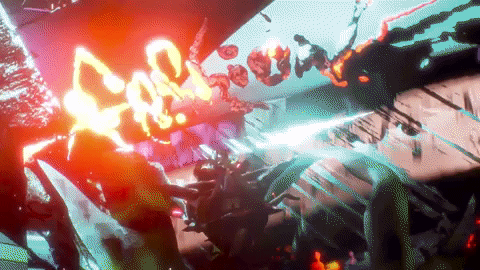
You are a multimedia artist and experimental electronic musician; with a background in arts and painting. How and when does the interest in mixed/altered reality come about?
My early focus on mixed media painting/digital print experiments, turntablism, and improvisational experimental sound performance were often based, albeit naively, on representations of identity and portraiture in digitally mediated spaces, along with a measure of live experimentation which is a focus that has become the formal backbone of my more performative and narrative-based 3D practice today.
Even when I was using physical media like painting, though, it was always in tandem with digital sketches and experiments investigating a collaged space of real imagery with simulated — my latest phase of work is just a more developed and successful format for accomplishing that goal.
A big change in medium came after I graduated art school and began experimenting with a 3D sculpting program that was far more expressive than what I’d been working with previously and felt very similar to the painting I’d been doing thus far. From there, our practice evolved organically from that foundation into experiments with motion capture, narrative improvisation, and performing on stage.
Talking about Join the Studio, who else is behind the collective? And what are the interests of the collective?
Join The Studio, lol! That was our old art and music collective I ran on and off from 2009 to 2013 or so, which threw experimental music and art shows in Austin and Chicago, had a brief clothing line sold in Dallas, and published a webzine filled with interviews of rising talent in the ‘beat scene’ during that time.
I miss those days, and we’re thinking of reviving the webzine on Patreon actually, but this time focused on digital performance and its intersection with left activism.
Our new project is Team Rolfes, a ‘real-time 3D performance and image house’ that focuses on expanding the artistic language of live 3D performance and does design and direction for clients in the music and fashion industries. It’s a studio that, to our frequent financial detriment, usually only takes on more creatively open or experimental client projects and attempts to find a method of formatting avant-garde work for broader audiences.
About your creative process, does your work generally involves a lot of conceptual development beforehand, or it stems more from an aesthetic need?
Usually, there’s a framework established beforehand on the motifs, theme, etc., and maybe some choreography and general plot moments developed, but then from there, it’s all about jumping into the 3D space and responding improvisationally and expressively within it. The framework is essential to have something to bounce off of and work with/against, but usually, the essential aspects of a piece will arise at the moment as we figure it outlives.
Could you tell us about your live performances (MoMA, MOFO…) haven’t seen any of your shows since Unsound last year where you performed with House of Kenzo. How has the show evolved/morphed, or is it something completely different?
Each major performance like the ones you named is, on one hand, a one-off, unique performance with its own featured performer/dances, environments, characters, choreography, and context, but on the other hand, each performance is a child of the ones before it, and the little universes that each major show generates are its own elaboration and recontextualization of our cast of characters.
Because of this, each performance space has grown to foster a few dozen small vignettes, scenes, and choreographic possibilities, getting more and more substantial with each show. Additionally, we’ve been far more explicit and considerate of narrative arcs, as well as developing our tools for unfolding the performance to the audience in an increasingly understandable progression. Because of this, our shows with House of Kenzo and Rabit will feel like the same universe as our MoMA performance with Justin Shoulder, but at a different place and time with different goals.
A new thing we’re excited about is the inclusion of audience interactivity, the ability for people online or in the IRL audience to upload photos, vote on story paths, or just generally cause chaos for us, which we have to respond to. We’re putting together a few Livestream projects which focus on this, and that’s largely my strongest passion right now: the unexpected beauty and humour that arises from the confluence of everything at the moment getting immediately upended by a Livestream chat and letting that guide the story.
You have been working with motion sensors and developing what you call virtual puppets. How the idea came up? And also, how is the interaction with your own virtual puppets?
I began the live VR performance practice simply by palming a VR headset to use as a camera in my first music video for Amnesia Scanner because I didn’t really have any other method of animating the POV and motion I was looking for. From there grew an interest in exploring the possibilities for digital expression via body-driven movement (whether via VR controllers, motion capture, or a combination thereof).
Not just in order to completely represent human whole-body movement necessarily, but also to explore beyond that point, to where a body can be more expressive and abstracted much in the way IRL puppetry abstracts and expands on human movement.
Technically, it’s not much different than the traditional method of rigging up 3D characters for motion, but the most interesting things happen when you create these novel and counter-intuitive ways of controlling them. Should the head rotation control the hand, which then is attached to cables pulling the bodies of other characters? Maybe the arms form the face when they come together, and the distance between the hands drives the expression of the eyes…it’s all dependent on the character qualities and artistic goals you’re going for
And where do you see taking the puppets show into? I imagine there are lots for exploring, either technical, conceptual or performative wise
As mentioned, more livestream and interactive, expanding the language and documented mechanisms of this improvisational performance practice (making more tools and toys), experiments with fast platforms like Tiktok and getting faster at making rapid-pace narrative experiments without the weight of a long production.
Larger scale productions on stage with more coherent narratives, but also more random small-scale bullshit for the internet to test the waters for a broader audience and figure out a way to present aspirationally avant-garde work to people outside of my Berlin art-boy niche.
Ultimately, a key goal is to find the social and political utility for this work — can this all be weaponized for an anti-imperialist and anti-capitalist movement? Determining the role of surrealism, subversive imagery (what even is subversive in an era where violent, noisy imagery can be just as easily marketed and consumed by platform capitalism), etc., in a rapidly dissolving world
How do you think new inventions (machine learning, Google Magenta, etc.) are impacting the landscape of art creation (from inception to production)? Do you think AI-generated art is changing the paradigms of art?
I think, like any emergent technology being wielded for artistic purposes, it has the potential for aiding the change of artistic paradigms, but a successful and compelling work is usually more dependent on the vision and capabilities of the creator.
AI allows us to accelerate the exploration of ourselves reflected in the black mirror, but too often, like so many other new technologies. It is used as a disposable stylistic novelty. I use this example all the time, but data moshing was an impactful but largely abandoned artistic practice that a few talented people found a real use for but was otherwise played out quickly for novelty’s sake.
Most of the technology you are using is developed by giant tech Silicon Valley companies which also get very keen on sponsoring artistic projects using these technologies. I see it as a way of legitimising themselves as philanthropic but at the same time imposing their thecnocapitalist dominance. How do you feel about the issue? And how do you find the right balance in your practice?
I agree completely; these major corporations are using artists to create pseudo-progressive marketing to act as a cover for their increasingly out-of-control attrition over our lives. Capitalism, especially through these accelerated, vertically integrated platform monstrosities we’re reliant on now, consumes and repurposes nearly everything radical or revolutionary for its own needs.
Digital artists who attempt to make a living in the weird art world-adjacent space of galleries, instal-friendly pop-up ‘museums’ and elsewhere are in a bit of a bind. In the US, there’s basically no real state funding for the arts that’s accessible en masse. The actual Art World is a pyramid scheme that hardly any artists profit from, there’s a (imo misguided) constant pressure to be using the most absolutely bleeding-edge tech tools (momentarily before moving on to the next novelty), and many of those tools are prohibitively expensive.
So, Google and others have become the new Medicis in a way, and both the conflict of interest inherent in that relationship and the speed of novelty required for new work has resulted in a lot of conceptually hollow tech demos masquerading as art, which largely only benefit the image of the manufacturer of the tech tools.
What is your chief enemy of creativity?
Probably a condition that I think affects most of us in neoliberal societies today: the general malaise of the isolated gig economy lifestyle, by that I mean the constant compulsion to create and be creative to survive with no waking time left for leisure and inspiration
You couldn’t live without…
I deny myself so much on a daily basis in service of productivity and focus that I’m inclined to say I couldn’t live without an artistic practice to underpin my sense of self-worth and give me an emotional scapegoat… however, I’m at the point where I wonder if that impulse is ultimately futile and I need to go outside and see the sun more.






